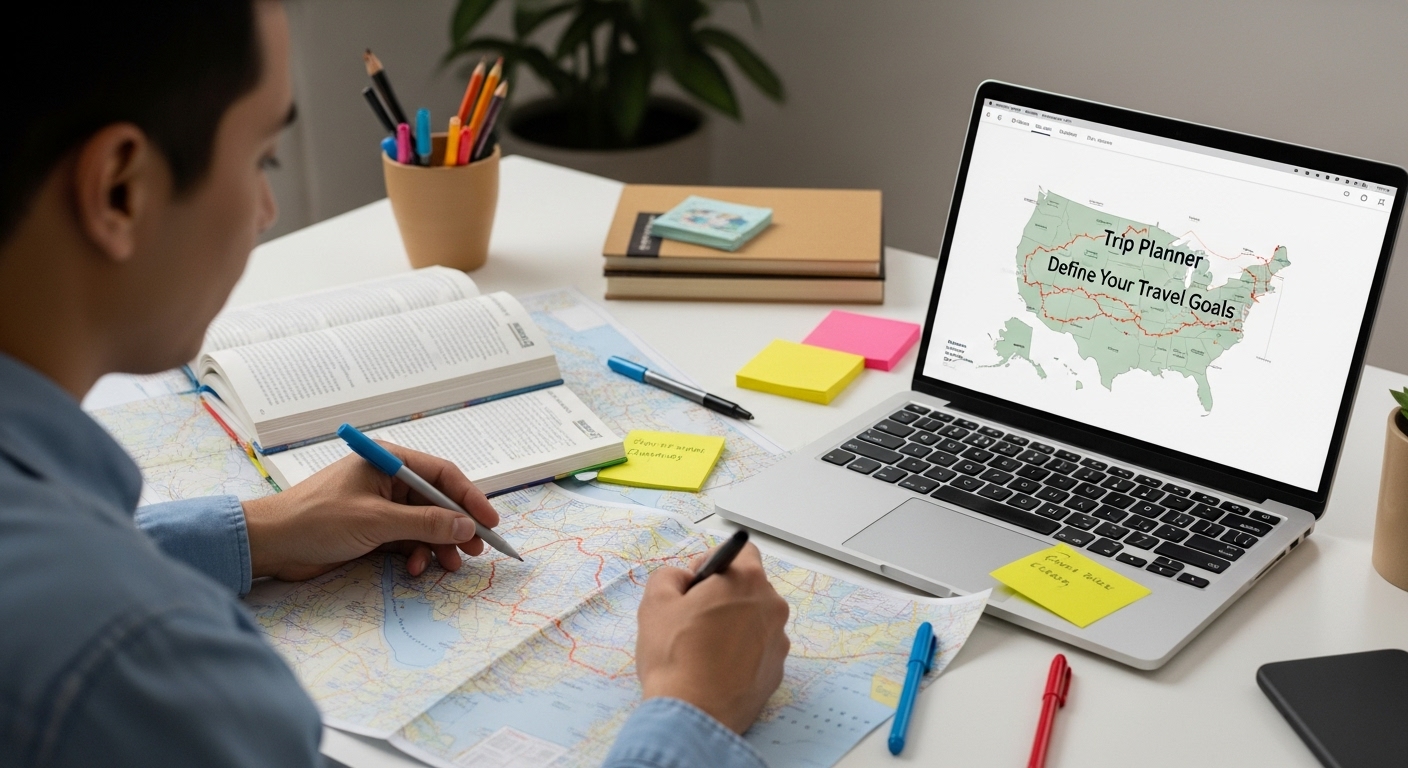Travel planning can feel overwhelming with endless options and constant logistics. Yet studies show that using a travel itinerary app can increase trip organization and satisfaction by up to 70 percent. Most people think any app will do the job, but the truth is you could end up with more stress if you pick the wrong one and miss key features that would have made your journey effortless.
Table of Contents
- Choose The Right Travel Itinerary App For Your Needs
- Customize Your Itinerary With Key Information
- Sync Your Itinerary Across All Devices
- Add Transportation And Accommodation Details
- Share Your Itinerary With Friends And Family
- Use Offline Features For Connectivity Issues
- Review And Adjust Your Itinerary As Needed
Quick Summary
| Takeaway | Explanation |
|---|---|
| Choose the right app for your needs | Evaluate apps based on user interface, customization, and offline access before committing. |
| Customize your itinerary for personal preferences | Incorporate personal interests, realistic timing, and flexibility to enhance your travel experience. |
| Ensure device synchronization for ease of access | Select apps that sync across devices for real-time updates, reducing planning stress. |
| Include transportation and accommodation details | Document all travel confirmations and contact information to streamline your journey. |
| Share itineraries for safety | Share your travel plans with trusted contacts and utilize privacy settings for security. |
1: Choose the Right Travel Itinerary App for Your Needs
Selecting the right travel itinerary app can transform your entire travel planning experience. The digital landscape offers numerous options, but finding the perfect match requires strategic evaluation. According to research from the University of Maryland’s Digital Literacy program, travelers should prioritize specific functional criteria when choosing a travel app.
When exploring travel itinerary apps, consider these critical factors:
- User Interface: Look for intuitive, clean design that makes navigation simple
- Customization Options: Ensure the app allows personalized trip modifications
- Offline Accessibility: Check if the app works without constant internet connection
The primary goal is finding an app that simplifies your travel planning process. A great travel itinerary app should seamlessly integrate multiple travel components including flight details, accommodation information, local transportation, and activity suggestions. This comprehensive approach eliminates the need for multiple disconnected tools.
Consider your specific travel style and preferences. Are you a meticulous planner who wants granular control, or do you prefer a more flexible, suggestion-based approach? Some travelers need minute-by-minute scheduling, while others want broader recommendations with room for spontaneity.
Before committing to an app, take advantage of free trials or demo versions. This allows you to test the app’s functionality and determine whether it genuinely meets your travel planning requirements. Pay attention to how smoothly you can add, modify, or remove elements from your proposed itinerary.
Remember that the best travel itinerary app is one that reduces stress and enhances your overall travel experience. It should feel like a helpful companion, not an additional burden. Look for apps with responsive customer support, regular updates, and a track record of positive user reviews.
By carefully evaluating your options and understanding your personal travel needs, you can select a travel itinerary app that becomes an indispensable tool in your journey planning arsenal.
2: Customize Your Itinerary with Key Information
Customizing your travel itinerary transforms a generic trip into a personalized adventure tailored precisely to your preferences. According to research from the National Renewable Energy Laboratory, personalized travel plans significantly enhance user satisfaction by incorporating individual preferences and travel behaviors.
When customizing your itinerary, focus on these essential elements:
- Personal Interests: Include activities that genuinely excite you
- Realistic Time Allocation: Schedule realistic time between destinations
- Flexibility Margins: Leave room for unexpected discoveries
Detailed information is the backbone of an exceptional travel plan. Begin by inputting comprehensive data about your destination, including local transportation options, weather patterns, cultural events, and potential travel restrictions. This approach ensures you are not just traveling but experiencing your destination authentically.
Consider your travel style and physical capabilities. Are you an adventure seeker who wants packed days of exploration? Or do you prefer leisurely experiences with ample relaxation time? Your itinerary should reflect your unique travel rhythm.
Technology enables unprecedented customization. Modern travel itinerary apps allow you to drag and drop activities, adjust timelines, and integrate real-time information. You can now craft a travel plan that feels like it was designed exclusively for you.
Prioritize your must-do experiences while maintaining flexibility. If a museum exhibit catches your eye or a local festival is happening, your digital itinerary can accommodate spontaneous changes without derailing your entire trip.
Remember that a great itinerary balances structure with spontaneity. Over-planning can create unnecessary stress, while under-planning might lead to missed opportunities. The goal is creating a roadmap that guides without constraining your travel experience.
By thoughtfully customizing your travel itinerary, you transform a simple trip into a meticulously crafted journey that resonates with your personal travel philosophy.
3: Sync Your Itinerary Across All Devices
In today’s interconnected world, travelers require seamless access to their travel plans across multiple devices. According to research from the U.S. Department of Transportation, data sharing and interoperability are critical for effective travel management.
When selecting a travel itinerary app, device synchronization should be a top priority. This feature ensures your travel details remain consistent whether you are checking information on a smartphone, tablet, or laptop.
Key considerations for effective device synchronization include:
- Real-time Updates: Instantaneous changes reflected across all connected devices
- Cloud Storage: Secure backup of your travel information
- Cross-Platform Compatibility: Works seamlessly on different operating systems
Synchronization eliminates the frustration of disconnected travel planning. Imagine updating your flight details on your phone during a taxi ride, and seeing those same changes instantly reflected on your laptop at home. This level of connectivity reduces stress and prevents potential travel mishaps.
Most modern travel itinerary apps offer cloud-based synchronization, which means your data is stored securely online and can be accessed from any device with internet connectivity. This approach provides multiple benefits beyond simple information sharing.
Secure your travel data by using apps with robust encryption and two-factor authentication. These security measures protect your personal information while ensuring you can access your itinerary from anywhere in the world.
Consider the frequency of your updates and the types of devices you typically use. Some travelers prefer seamless transitions between smartphones and tablets, while others need comprehensive desktop access for detailed planning.
A well-designed travel itinerary app should feel like a personal travel assistant that knows exactly what you need, when you need it. Synchronization is not just about sharing information, but about creating a unified, stress-free travel planning experience.
By prioritizing device synchronization, you transform your travel planning from a fragmented process into a smooth, integrated journey of preparation and anticipation.
4: Add Transportation and Accommodation Details
Comprehensive travel planning requires meticulous attention to transportation and accommodation details. According to research from the Federal Highway Administration, integrating transportation information enhances overall trip management and user convenience.
When adding transportation and accommodation details to your travel itinerary, consider these critical elements:
- Transportation Modes: Include flights, trains, buses, car rentals
- Accommodation Specifics: Add hotel addresses, check-in times, reservation numbers
- Contact Information: Store emergency and booking contact details
Precise documentation transforms potential travel chaos into a streamlined experience. Begin by inputting all transportation confirmation numbers, departure and arrival times, and specific travel routes. This approach eliminates last-minute confusion and provides a clear roadmap for your journey.
For accommodations, go beyond basic booking information. Include details such as room type, special requests, parking options, and proximity to key destinations. Some advanced travel itinerary apps allow you to map your hotel’s location in relation to planned activities, helping you understand your transportation needs.
Digital tools now enable travelers to store multiple transportation tickets and accommodation confirmations in one centralized location. This consolidation reduces the risk of losing critical travel documents and provides instant access to important information.
Consider potential travel complications by adding buffer times between transportation connections and accommodations. Unexpected delays can quickly derail a tightly scheduled trip, so building flexibility into your itinerary is crucial.
Utilize your travel itinerary app’s features to store digital copies of important documents. Passport information, travel insurance details, and reservation confirmations should be easily accessible, even when you are offline.
Remember that comprehensive travel planning is about anticipating potential challenges. By meticulously documenting transportation and accommodation details, you create a robust framework that allows for smoother, more enjoyable travel experiences.
Your digital itinerary becomes more than just a schedule it transforms into a comprehensive travel companion that supports and guides you throughout your journey.
5: Share Your Itinerary with Friends and Family
Sharing your travel itinerary with friends and family is more than a courtesy it is a critical safety measure. According to recommendations from the Centers for Disease Control and Prevention, travelers should proactively communicate their travel plans with trusted contacts.
Key considerations when sharing your travel itinerary include:
- Privacy Settings: Control who can access your detailed travel information
- Emergency Contacts: Provide comprehensive contact details
- Real-time Updates: Enable automatic location and status sharing
Digital sharing transforms travel safety and communication. Modern travel itinerary apps offer sophisticated sharing mechanisms that allow you to grant specific access levels to different contacts. This means you can share comprehensive details with immediate family while providing limited information to broader networks.
Consider creating different sharing profiles based on relationships. Your spouse might need full access to your travel details, while a colleague might only require basic information about your availability.
Some advanced travel apps enable live tracking and automatic check-in notifications. These features provide peace of mind for both travelers and their loved ones. Imagine your family receiving an automatic notification when you safely arrive at your destination or pass through a specific checkpoint.
Be strategic about the information you share. While transparency is important, you do not want to compromise your personal security. Select apps that offer granular privacy controls, allowing you to customize exactly what information is visible.
Encourage your shared contacts to download the same travel itinerary app. This creates a seamless communication ecosystem where everyone can stay informed about your travel progress without constant manual updates.
Remember that sharing your itinerary is about creating a safety network. In emergency situations, having readily available travel information can make a significant difference in response time and support.
By leveraging technology to share your travel plans, you transform potential travel anxiety into a collaborative, connected experience that keeps you safe and your loved ones informed.
6: Use Offline Features for Connectivity Issues
In an era of global travel, reliable access to your travel information is paramount, even when internet connectivity becomes unpredictable. According to research on mapping applications, offline features are critical for maintaining seamless travel experiences.
Key considerations for offline travel app functionality include:
- Complete Itinerary Downloads: Save entire trip details for offline access
- Map Caching: Preload destination maps before traveling
- Reservation Information: Store booking confirmations without internet
Offline features transform your travel app from a connected tool to a comprehensive travel companion. Before departing, take time to download all necessary information. This includes maps, transit schedules, accommodation details, and critical travel documents.
Most advanced travel itinerary apps now provide robust offline capabilities. These features allow you to access your entire travel plan, even in remote locations or areas with limited cellular coverage. Imagine trekking through a mountain region or exploring a rural destination where internet connectivity is sporadic your travel app remains your reliable guide.
Prioritize apps that offer complete offline functionality. This means not just static information, but interactive features like route planning, translation services, and emergency contact details. Some apps even provide offline currency converters and local language support, ensuring you remain prepared in any situation.
Be strategic about your offline preparation. Download maps and itineraries while connected to reliable wifi, preferably before your trip begins. Some travelers create multiple offline backups by screenshotting critical information or emailing themselves important documents.
Consider the storage requirements for offline features. Large map downloads and comprehensive itinerary details can consume significant smartphone memory. Manage your digital storage carefully, removing unnecessary files to ensure smooth offline functionality.
Remember that offline features are more than a convenience they are a critical travel safety tool. By preparing your travel app for disconnected scenarios, you ensure continuous access to essential information, regardless of your location or network availability.
7: Review and Adjust Your Itinerary as Needed
Travel is inherently unpredictable, making flexibility a crucial component of successful trip planning. According to research from the U.S. Geological Survey, adaptability is key to managing travel effectively.
Critical considerations when reviewing and adjusting your travel itinerary include:
- Real-time Information: Monitor local conditions and potential disruptions
- Backup Plans: Create alternative routes and activity options
- Contingency Budgeting: Reserve financial resources for unexpected changes
Digital travel itinerary apps provide unprecedented flexibility for travelers. These tools allow you to make instantaneous modifications, ensuring your travel plans remain responsive to changing circumstances. Whether it is a weather disruption, transportation delay, or unexpected local event, your app becomes a dynamic planning tool.
Consider checking your itinerary at least three key moments: before departure, midway through your trip, and 24 hours before major travel connections. This proactive approach helps you anticipate and mitigate potential travel challenges before they become significant issues.
Some advanced travel apps now offer predictive adjustment features. These intelligent systems can suggest alternative routes, recommend schedule modifications, and even help rebook transportation if unexpected changes occur. Technology transforms potential travel disruptions from stressful experiences into manageable adjustments.
Maintain a balance between structured planning and spontaneous exploration. While your itinerary provides a framework, remain open to unexpected opportunities. The most memorable travel experiences often emerge from unplanned moments and last-minute discoveries.
Utilize your app’s notification systems to receive instant updates about your destinations. Flight delays, local transportation changes, and weather alerts can all be integrated directly into your travel plan, allowing for seamless real-time adjustments.
Remember that an excellent travel itinerary is a living document, not a rigid script. By embracing flexibility and leveraging technology, you transform potential travel obstacles into opportunities for unique experiences and memorable adventures.
Below is a comprehensive table summarizing the article’s 7 essential tips for using a travel itinerary app, including main focus areas and key benefits for travelers.
| Tip | Main Focus | Key Benefits |
|---|---|---|
| Choose the Right App | Evaluate interface, customization, offline access | Reduces stress, integrates all trip details, fits travel style |
| Customize Your Itinerary | Add personal interests, realistic timing, flexibility | Enhances enjoyment, enables authentic experiences |
| Sync Across All Devices | Ensure real-time updates, cloud storage, compatibility | Keeps plans up-to-date and accessible everywhere |
| Add Transportation & Accommodation Details | Include confirmation numbers, addresses, contact info | Streamlines travel, avoids confusion, stores key documents |
| Share with Friends & Family | Control privacy settings, provide emergency contacts | Increases safety, enables real-time updates, peace of mind |
| Use Offline Features | Download itinerary, cache maps, store reservations offline | Maintains access without internet, ensures reliability |
| Review & Adjust as Needed | Monitor real-time info, prepare backup plans, budget for changes | Enhances flexibility, quickly adapts to disruptions |
Transform Your Travel Planning With Yopki’s Intelligent Itinerary Tools
Are you tired of juggling spreadsheets and disconnected apps to keep up with your travel plans? This guide on using a travel itinerary app highlights the need for all-in-one solutions that truly fit your lifestyle. If you want a seamless way to customize itineraries, organize transportation, and sync travel details across devices, Yopki is designed to solve exactly these challenges.

Get instant personalized itineraries, drag-and-drop scheduling, and access to all your tickets in one central hub. With Yopki, you can plan smarter, adapt to real-time changes, and share details securely with loved ones. Stop letting travel logistics create stress. Visit Yopki’s homepage to start your effortless planning experience today, and make your next journey truly unforgettable.
Frequently Asked Questions
What should I consider when choosing a travel itinerary app?
Select a travel itinerary app that offers an intuitive user interface, customization options, and offline accessibility to enhance your travel planning experience.
How can I customize my travel itinerary for a better experience?
Focus on incorporating your personal interests, realistic time allocation, and flexibility margins to create a personalized itinerary that reflects your travel style.
Why is device synchronization important for a travel itinerary app?
Device synchronization ensures your travel details are consistent across all devices and allows real-time updates, reducing the risk of missing important information during your trip.
What offline features should I look for in a travel itinerary app?
Look for apps that offer complete itinerary downloads, map caching, and the ability to store reservation information without needing an internet connection.



